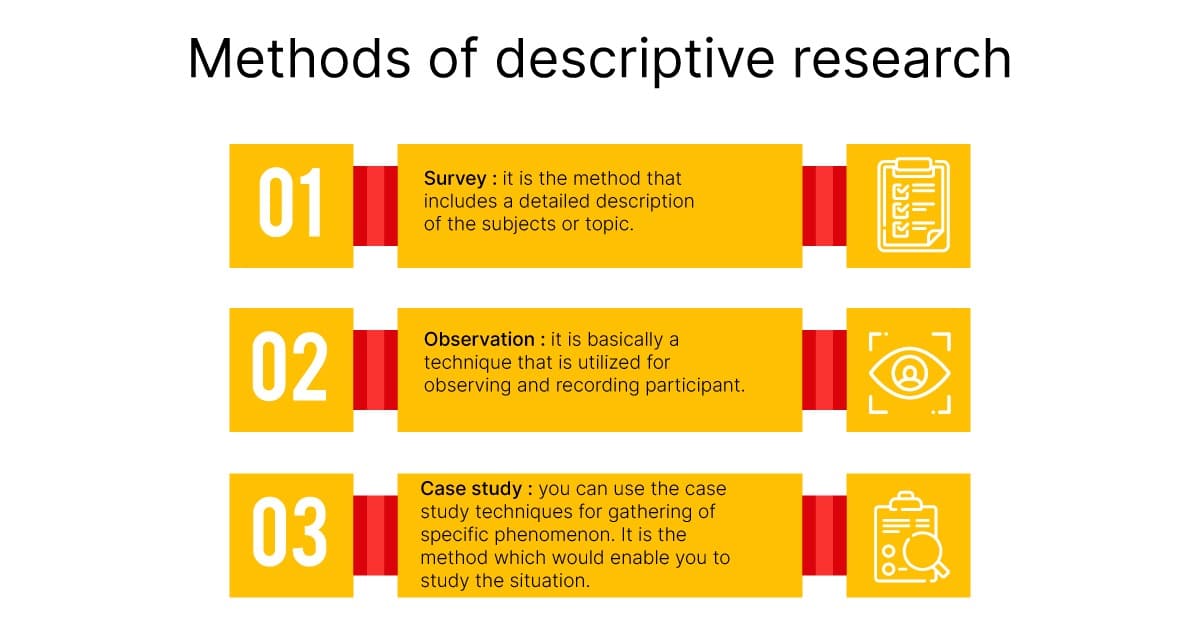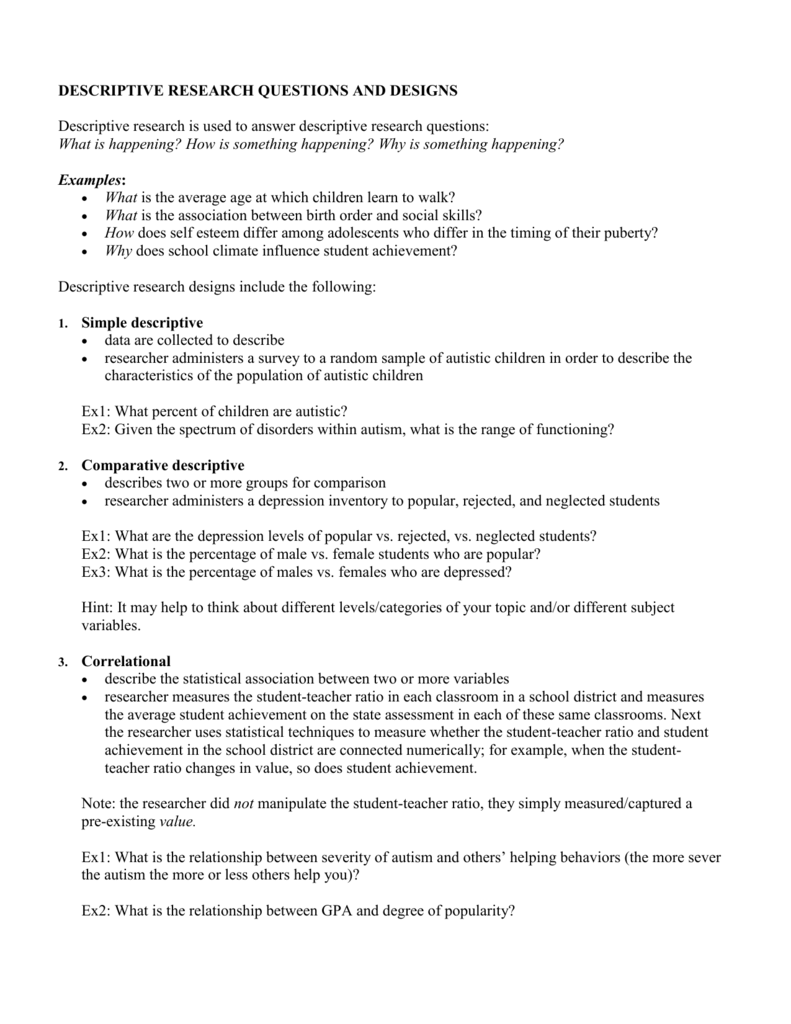Table Of Content

These units include individuals, families, organizations, objects, characteristics, and properties. You can further dissect descriptive research’s outcomes and use them for different types of investigation. The outcomes also serve as a foundation for subsequent investigations and can guide future studies. For example, you can use the data obtained in descriptive research to help determine future research designs. Besides making observations and then comparing and analyzing them, descriptive studies often develop knowledge concepts and provide solutions to critical issues.
Importance of Descriptive Research in Scientific Studies
Determining when to use descriptive research depends on the nature of the research question. Before diving into the reasons behind an occurrence, understanding the how, when, and where aspects is essential. Descriptive research design is a suitable option when the research objective is to discern characteristics, frequencies, trends, and categories without manipulating variables. It is therefore often employed in the initial stages of a study before progressing to more complex research designs.
Descriptive study of earthquake-related spinal cord injury in Nepal Spinal Cord - Nature.com
Descriptive study of earthquake-related spinal cord injury in Nepal Spinal Cord.
Posted: Tue, 14 Mar 2017 07:00:00 GMT [source]
WHAT IS A DESCRIPTIVE STUDY?

The survey method can be conducted online or offline, making it the go-to option for descriptive research where the sample size is enormous. Researchers can conduct various investigations and collect multiple types of data (quantitative and qualitative) using surveys with diverse designs. Descriptive studies are usually carried out in the participants’ everyday environment, which allows researchers to avoid influencing responders by collecting data in a natural setting. Case reports and case-series refer to a solitary patient or to only a few cases, who may represent a chance occurrence. Hence, conclusions based on these run the risk of being non-representative, and hence unreliable. Descriptive research is used to describe characteristics of a population or phenomenon being studied.
Descriptive Research Design Examples
Descriptive research is most appropriate when researchers aim to portray and understand the characteristics of a phenomenon without manipulating variables. Researchers must carefully consider descriptive research methods, types, and examples to harness their full potential in contributing to scientific knowledge. The research will provide a more accurate picture of a population’s demographic makeup and help to understand changes over time in areas like population age, health and education level. By understanding how the different demographics respond within your sample you can identify patterns and trends.
It’s helpful when trying to understand a larger community’s habits or preferences. Several descriptive research methods can be employed, and these are more or less similar to the types of approaches mentioned above. As an observational method, descriptive research will not tell you the cause of any particular behaviors, but that could be established with further research. This type of study uses qualitative observations to understand human behavior within a particular group. For example you could gather detailed data about a specific business phenomenon, and then use this deeper understanding of that specific case. When conducting descriptive research it’s important that the initial survey questions are properly formulated.
Cause-and-effect correlations also can’t be established through descriptive investigations. Additionally, observational study findings cannot be replicated, which prevents a review of the findings and their replication. This descriptive type of research employs surveys to collect information on various topics. This data aims to determine the degree to which certain conditions may be attained. Descriptive research is a cross-sectional study because it examines several areas of the same group. It involves obtaining data on multiple variables at the personal level during a certain period.
Bias
As we’ve mentioned, descriptive research design is ideal for understanding the what, who or where of a situation or phenomenon. Because the elements needed for descriptive research design are not specific or highly targeted (and occur within the respondent’s natural environment) this type of study is relatively cheap to carry out. Because the data collection for descriptive research produces statistical outcomes, it can also be used as secondary data for another research study.
Breaking Barriers: Sony and Nature unveil “Women in Technology Award”
Scientists use knowledge about the nature of electrons, protons and neutrons to devise this categorical scheme. We now take for granted the periodic table, yet it took descriptive research to devise it. For example, over time the periodic table's description of the elements allowed scientists to explain chemical reaction and make sound prediction when elements were combined. The term descriptive research then refers to research questions, the design of the study, and data analysis conducted on that topic. We call it an observational research method because none of the research study variables are influenced in any capacity.
The insights gained from a descriptive research can inform future research and inform policy decisions and programs. Focus group research involves bringing together a small group of people to discuss a particular topic or product. Furthermore, the group is usually moderated by a researcher and the discussion is recorded for later analysis. Data analysis involves using various methodologies, enabling the researcher to evaluate and provide results regarding validity and reliability.
Descriptive research typically involves the collection of both qualitative and quantitative data through methods such as surveys, observational studies, case studies, or focus groups. Descriptive research provides a comprehensive picture of the characteristics and behaviors of a particular population or phenomenon, allowing researchers to gain a deeper understanding of the topic. The primary advantage of descriptive research designs is that researchers can create a reliable and beneficial database for additional study. To conduct any inquiry, you need access to reliable information sources that can give you a firm understanding of a situation. A case study can be used to describe the characteristics of a specific subject (such as a person, group, event, or organisation). Instead of gathering a large volume of data to identify patterns across time or location, case studies gather detailed data to identify the characteristics of a narrowly defined subject.
In a descriptive research design, the researcher can choose to be either a complete observer, an observer as a participant, a participant as an observer, or a full participant. For example, in a supermarket, a researcher can from afar monitor and track the customers’ selection and purchasing trends. This offers a more in-depth insight into the purchasing experience of the customer. Case study research is a type of descriptive research that focuses on a single individual, group, or event.
Several descriptive research examples are emphasized based on their types, purposes, and applications. Research questions often begin with “What is …” These studies help find solutions to practical issues in social science, physical science, and education. To conduct effective research, you need to know a scenario’s or target population’s who, what, and where. Obtaining enough knowledge about the research topic is an important component of research. The main goal is to observe and catalog all the variables and conditions that affect the phenomenon. Observation of physical entities and phenomena is also an important part of research in the natural sciences.
This means you can use the stats gathered to easily identify underlying patterns in your respondents’ behavior. For example you could use descriptive research to understand fashion trends in a given city when planning your clothing collection for the year. Using descriptive research you can conduct in depth analysis on the demographic makeup of your target area and use the data analysis to establish buying patterns. Qualitative observation doesn’t involve measurements or numbers but instead just monitoring characteristics. Since the respondents are in a comfortable environment, the characteristics observed are natural and effective.
Descriptive research design is a powerful tool used by scientists and researchers to gather information about a particular group or phenomenon. This type of research provides a detailed and accurate picture of the characteristics and behaviors of a particular population or subject. By observing and collecting data on a given topic, descriptive research helps researchers gain a deeper understanding of a specific issue and provides valuable insights that can inform future studies. Descriptive research methods can include surveys, observational studies, and case studies, and the data collected can be qualitative or quantitative. The findings from descriptive research provide valuable insights and inform future research, but do not establish cause-and-effect relationships.
Descriptive studies, irrespective of the subtype, are often very easy to conduct. For case reports, case series, and ecological studies, the data are already available. For cross-sectional studies, these can be easily collected (usually in one encounter). Thus, these study designs are often inexpensive, quick and do not need too much effort.

No comments:
Post a Comment